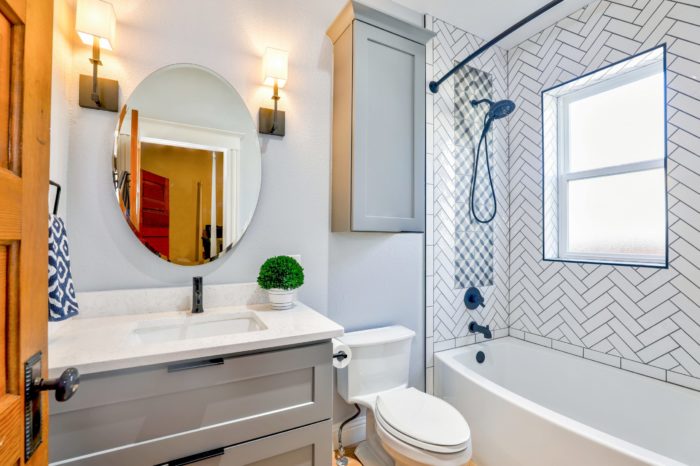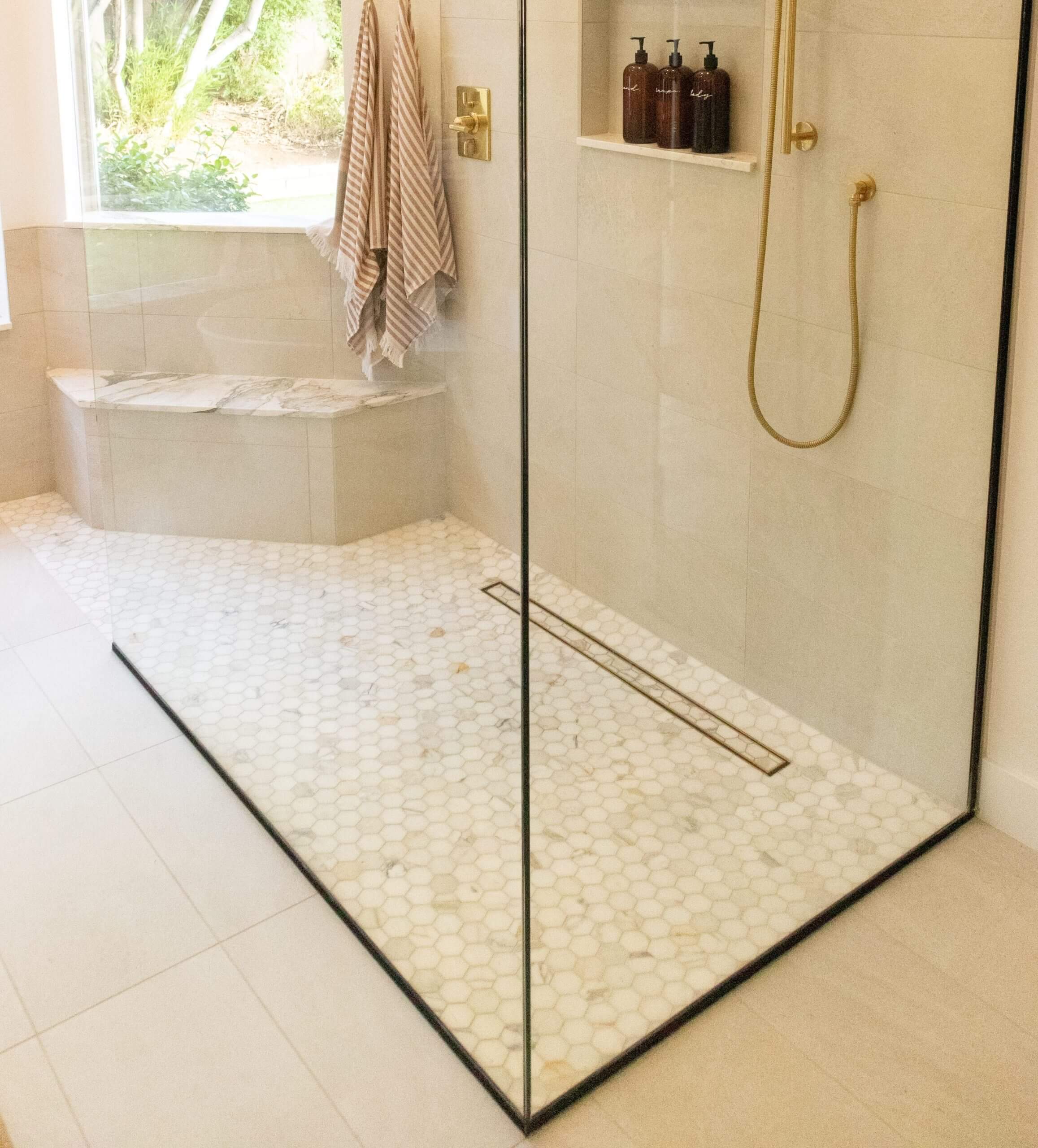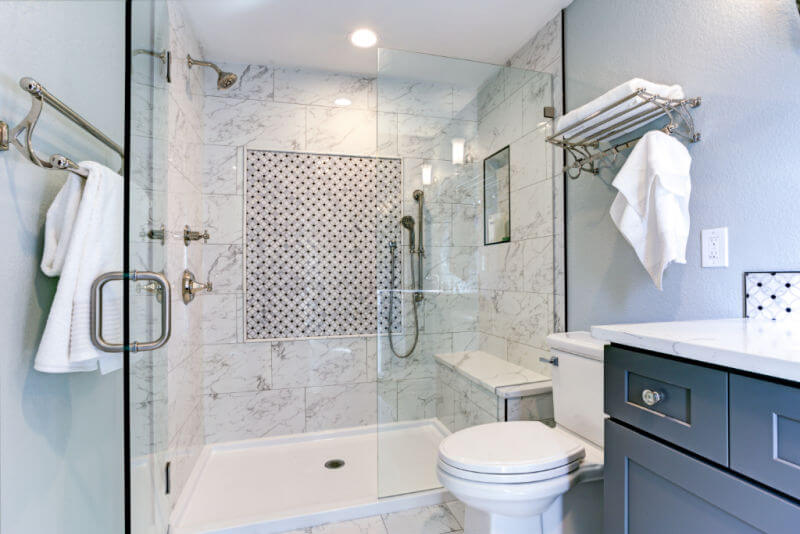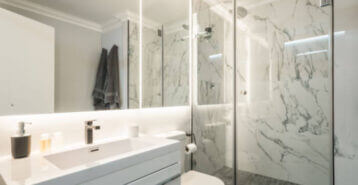Are you doing a bathroom remodel project?
Modernize can pair you with three to four pros in your area, so you can compare options and save time and money.
Building a custom shower can make your spa dreams come true. Imagine stepping into an oasis that was actually built just for you and includes everything you need to relax and rejuvenate. That custom shower might take many forms, but what matters is that it suits you and your personal style.
With that being said, there are some down-to-earth considerations, like your budget. Let’s take a look at how to build a custom shower for your home.

Step 1: Look at Your Budget
It can be easy to go wild with all the options for a custom shower, and that can easily reach into the tens of thousands of dollars. If you can go all-out and create that kind of shower, by all means, go for it (and send us pictures when you’re done!).
But most of us can’t afford to drop that kind of money on a custom shower, so we have to start choosing the things that matter most to us or learning where it’s okay to cut corners. Does it really matter to you to have a steam sauna as part of your shower, or would you rather use the cash to knock out part of a wall for a true walk-in shower? Do you really need all the body jets, or are you okay with a unique rainshower fixture and a shower wand?
Start out by listing everything you want, with no holds barred. Write out those prices. And then start tweaking, removing, and changing things to find a lower cost. Keep in mind that you need a 10-20% buffer in case things go wrong, and you’ll need to add the cost of labor to your custom shower work.
Step 2: Choose the Shower Enclosure Style
A custom shower can take any form you like. Most people opt for a corner shower or an alcove shower that replaces the space originally intended for a bathtub. Some might choose to simply enclose their bathtub with shower doors, thus saving a great deal of money.
However, many choose an entirely separate shower, one that might be a feature in the corner of the room or, if you have the space, right in the center of a long wall, creating a focal point for the rest of the room. Some might even choose to knock out a closet or smaller bedroom or even convert a half-bath to a shower for a true spa experience.
If you’re on a tighter budget, prefabricated shower kits work well. A luxurious shower can be had through a prefab model fashioned in a rectangle, square, or even round shower enclosure. Acrylic and fiberglass are the most common enclosure options. If your budget is a bit broader, you could opt for a shower built from the ground up using tile, stone, glass block, and more.
Step 3: Choose a Type of Shower Door
Choosing a custom shower door can be just as important as choosing the materials for your shower walls. Here are the options:
- Framed. The framed shower door is a traditional style that uses hardware along all sides of the door to keep the glass in place. This is often made with a thinner glass than the other options, potentially allowing for a better view. The metal frames come in a wide variety of finishes that can look quite high-end, including gold or composite metal.
- Frameless. The frameless shower door uses glass panels that don’t have framing support systems. As a result, they provide a more seamless look and can show off expensive, high-end fixtures. These are usually made with thick safety glass.
- Semi-Frameless. A semi-frameless shower door has some hardware, usually on the top and bottom, which holds the shower door in place. The shower door itself is made of thick safety glass. The result is a shower door that helps keep the water inside, where it belongs, but also opens up the bathroom in a visual sense.
- Walk-in. The walk-in shower doesn’t have a door at all; instead, it has an open area you can walk right in. The opening is usually at the back of a rectangular shower space, so the water from the showerhead doesn’t reach far enough back to flood out onto the bathroom floor. The lack of hardware around a door can lend an elegant appearance to the shower stall.
How your shower door moves is also a consideration. Do you want a custom shower door that pivots when you push on the handle? Do you prefer sliding glass, also known as a bypass door? If you have a walk-in shower, it doesn’t really matter. If you have a shower/tub combination, you can opt for the popular sliding glass option, or if the aesthetic is a more retro or vintage look, you can go with a shower curtain.
Step 4: Determine a Size
The ideal shower is as big as you want it to be, but most people will go with at least 36 x 48 inches. That size will give you room to move around without bumping the shower walls. However, 60 inches in width is more standard for a luxury shower. Going much larger might necessitate knocking down walls to a bedroom or closet in a smaller bathroom, but it could be well worth it.
Step 5: Inspect the Plumbing
This is a crucial step that should be done before you begin ordering anything for your custom shower. In many cases, the plumbing will be just fine, especially if your home is a newer one. You might have to move some of the pipes or install a diverter, depending upon your plans, but this can be easily handled by a qualified plumber. You might also need to adjust the drainage to handle more water, especially if you are using several jets or showerheads.
Find the Right Contractor for Your Bathroom Remodeling Project
Whether you’re ready to begin your project now or need some expert advice, our network of contractors are here to help. With a few simple questions, we’ll find the best local professionals for you
However, a contractor might open up the walls to find bad things lurking, such as leaks, very old pipes that will be impossible to work with, or even the mold and mildew that can come from leaks that have been allowed to drip for a long time. This can add serious cost to your bathroom remodel and shower work, so make sure you get the thumbs-up from the plumber or shower installer before you move ahead.
One other thing to consider: You might need to upgrade your water heater. If you are going all-out with a custom shower that encases you in a wonderful deluge of water, you’ll need a water heater that can keep up with that demand.

Step 6: Choose Materials For Floors and Walls
You can get quite creative with the materials you choose for your shower, but some materials, such as those that make up the shower floor pan, are pretty standard:
- Acrylic
- Fiberglass
- Molded composite
- Tile
Acrylic and fiberglass are the most common, followed by molded composite. Tile is a pricier option, especially if you want a custom shower that uses tile throughout and thus appears as a seamless design from top to bottom.
Materials for the walls can be any of those listed above, as well as some more unique materials, such as natural stone or glass block. One of the most common wall materials for the shower is tile, as it has so many versatile options to choose from. From wide subway tiles to tiny mosaics, there’s something for every visual interest. Many choose to include more than one option, such as natural stone panels with tile accents running at the top or bottom, or using mosaic tile on built-in shelving units.
Keep in mind that acrylic and fiberglass are often the most affordable options.
Step 7: Choose Fixtures and Showerheads
Don’t discount the visual impact of the fixtures and showerheads in your custom shower. Popular showerhead options include a detachable showerhead or a stationary one with a secondary wand; this is especially popular in accessible showers. Rainshower showerheads are popular for larger showers to provide a more luxurious feel. Showerheads combined with jets that hit the body from all sides are also popular, but tend to be the most expensive option, as the plumbing involved can be extensive. If you choose jets, consider that they are ideal for massage. Positioning them at the height of your shoulder, lower back, and upper leg is usually best.
Would you like to create a shower that is even more luxurious with the addition of a bench or seat? Even a smaller shower can probably handle a fold-down seat. A built-in bench should have a non-skid coating so the seat feels safe even when covered in water. If a seat in the shower really matters to you, go back to your shower dimensions and make sure you can include it without impeding movement as you turn around in the shower.
When placing the seat or bench, think about the showerheads. The last thing you want is a showerhead that hits you right in the face when you choose to sit down. Consider the position of the bench and the showerhead before you make your final plans.
The handles and valves that operate the shower come in a wide variety of trim and styles. They all basically work the same, so it comes down to a matter of design and personal preference. Take your time to look at a variety of options and let your contractor know exactly what you want, so they can rough-in the walls accordingly.
Finally, consider the storage in your shower. Built-in shelves, especially those recessed into the wall, can provide visual interest as well as a place to store essentials. Make sure your storage is tall enough to accommodate shampoo and conditioner bottles, and add in a hook or two for loofahs and the like.
Find the Right Contractor for Your Bathroom Remodeling Project
Whether you’re ready to begin your project now or need some expert advice, our network of contractors are here to help. With a few simple questions, we’ll find the best local professionals for you
Reviews from Real Homeowners
Welcome to Homeowner Resources! We are the Modernize blog. Modernize pairs more than 3 million homeowners a year with pre-vetted contractors in their area. This blog started because we believe homeowners should know everything about their homes, from how their HVAC works to which front door colors they might love. On Homeowner Resources, you can find information on every part of your home, right down to how you can negotiate with contractors to get the best price. Here's more about the blog.
Need a contractor? Learn more about how Modernize finds the right pro for you.





